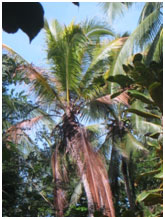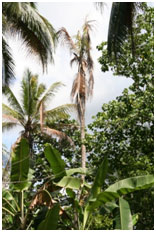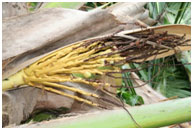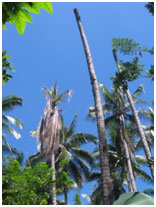Phytoplasmas
What to look for
Depending on the disease, look for:
- fronds turning brown and hanging down the stem before falling
- dry rot developing in the newly expanding spear
- the premature dropping of fruit of all ages, ripe or otherwise
- rotting and blackening of newly opened flowering shoots.
What you can do
- Do not move plants, plant material (particularly coconut seedlings or foliage) or soil out of the Torres Strait Protected Zone to the Torres Strait Permanent Biosecurity Monitoring Zone, or from either zone to mainland Australia without a permit and an inspection by a departmental biosecurity officer.
- Report any signs of suspect coconut plant diseases to the department by phone on +61 7 4241 7800 or email NAQS.

Profile
There are several lethal diseases of coconut and other palm trees around the world caused by phytoplasmas, which are unique disease-causing agents related to bacteria, but which behave like viruses in many ways. The phytoplasmas are spread from tree to tree by insects. Once infected, the tree quickly declines and dies only several months after showing first symptoms.
Identification
Different phytoplasmas cause slightly different symptoms. In the case of diseases closest to Australia, fronds turn brown and hang down the stem before later falling, eventually leaving only the crownless stem. Dry rot develops in the newly expanding spear, progressing downwards to the growing point where foul-smelling internal secondary rot develops. A common early symptom is premature dropping of fruits of all ages, whether they are ripe or not. Another is rotting and blackening of newly opened flowering shoots (inflorescences).

First, the older fronds of affected trees turn brown and hang down

Later, damage becomes more extensive and the growing point can rot
Distribution
Four important coconut diseases are found in countries to Australia’s north. The closest threat to Australia is a new disease recently discovered in Papua New Guinea. This phytoplasma is devastating coconut production in northern New Guinea. Another phytoplasma has been spreading through coconut plantings in parts of central Indonesia for much longer.
Threat
Coconuts have a high aesthetic and monetary value as landscape and ornamental plants in northern Australia. Although palms are not grown as a cash crop in Australia, they are important ornamental garden plants and are also a significant part of Australia’s tourism industry in the tropics.
Keep a Top Watch!
These diseases would be most likely to move with seedlings or with palm foliage carrying infective insects. Seed transmission may also be possible. Biosecurity is the only way to stop the disease from spreading. Watch out for any spreading sickness of coconuts or other palms and if you suspect something, contact the department immediately.

An early symptom can be rotting of both male and female flowers in the inflorescences

Eventually, only a crownless stem remains
Report sick-looking coconut trees.
